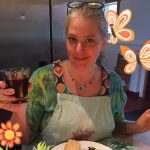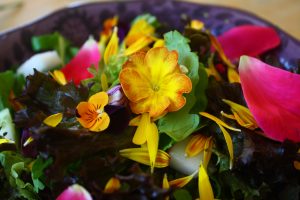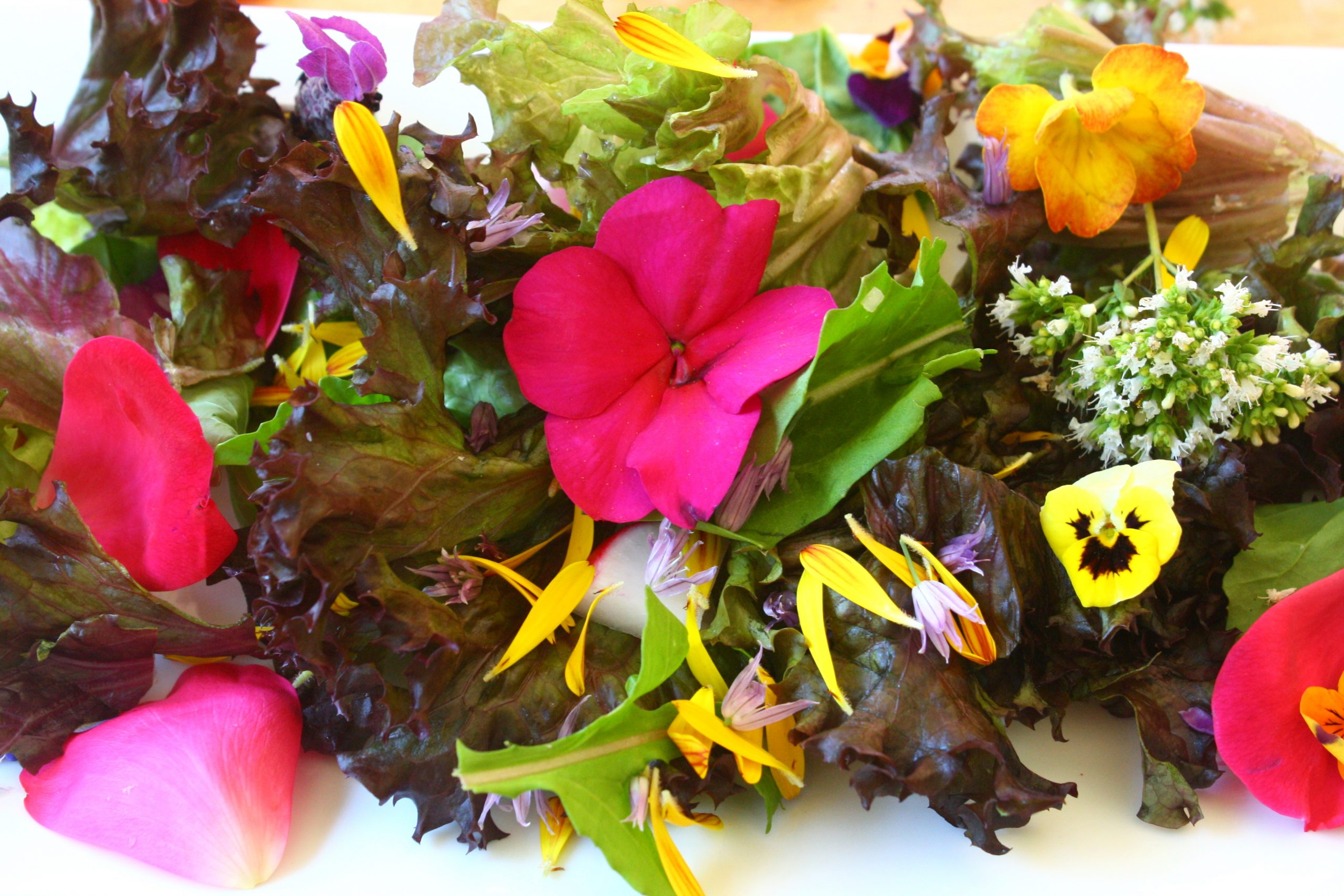 By Dana Zia, The Golightly Gourmet
By Dana Zia, The Golightly Gourmet
“Flowers are lovely, flowers are nice, I like flowers mixed with rice.” – Mary Rosewood
What a lush time of year! It is like a symphony of colors and abundance. The vegetables that the sun has tenderly serenaded for months are responding with a magnificent crescendo. And the flowers, oh my the flowers! They are the dancers blooming and bobbing around to the music of everything growing. As I see them pirouetting about, I think how sweet they will taste in my salad.
Eating flowers is not just my obsession; it goes back in time and has become almost a lost culinary treat. The Romans used mallow, roses and violets in many of their dishes. The piquant caper, which is the flower bud of the Mediterranean evergreen, has also been used in European cooking for over 2000 years. Queen Victoria was really into flowers in all her food so there was a surge of flower power during the Victorian Era. But then they gently faded from the kitchen and back into the garden until the last decade.
Most folks aren’t aware how many flowers are edible. When one thinks “edible flowers” the mind pulls up voluptuous roses and sweet lavender. Yet there are well over 40 edible flowers growing right here in the Northwest and quite possibly your back yard. Before you go out and start foraging there are a few safety tips to keep in mind.
First off, know your edible flowers so you won’t eat something poisonous like foxgloves which can give you a heart attack. Second, only eat blossoms that you know haven’t been sprayed with chemicals, preferably from your yard or your organic farmer. Flowers have a tendency to store any pesticides or whatnot used on them, so can be toxic. Some people remove the stamens before eating if they are prone to pollen allergies. Generally the sepals of most flowers are also removed except on violas and pansies. (But I have been known to eat them if they aren’t tough and bitter.)
It’s best to pick flowers just before you want to use them and when they are just opened, then wash carefully in cold water. Once well washed, allow them to dry naturally at room temperature on a clean kitchen towel. They can then be stored in the refrigerator in a plastic bag with a damp paper towel in it, until ready to use but preferably not longer than 3 days.
Now that we got that out of the way, let’s do some flower cookery. The easiest way to add flowers into your dishes is to toss them into salads. They add such beauty! Flowers tend to have a very mild and gentle flavor so take that into account when you are working with them. So be careful with the loud flavors like garlic and onion in your flower power salad.

Here are some other great ways to use flowers in your food:
- Decorate desserts such as cupcakes and sorbets with candied edible flowers
- Make a flower petal tea
- Add flower petals to egg dishes such as omelets and scrambles
- Drop edible flowers into drinks
- Make syrups with them for serving over ice cream, pancakes or anything!
- Toss flower petals such as calendula* into your rice pot for a lovely color
*Calendula is North America’s saffron in color and taste (well, almost)
- Make an extract or water (i.e. rosewater) and use in your recipes instead of vanilla
- Freeze ice cubes* with flowers in them to serve with your drinks
*Boil water first to make sure the ice cubes are crystal clear
- Add flower petals to a cake, biscuit and cookie batters for a lovely lift
Now the part you have all been waiting to learn; what flowers are edible? I am going to group the flowers in two categories, sweet and savory. My personal favorite sweet flowers are impatiens, lavender, primrose, viola, pansy, roses, chamomile, clover and violets. The favored savory flowers are chive, garlic, leek, sage, rosemary, calendula, nasturtiums, kale, scarlet runner beans, basil and borage. Some flowers that are edible that might come as a surprise are fuchsias, day lilies, gladiolus, snapdragons and peony. But I’ll warn you right now, snapdragons are really bitter!
The best way to learn more is to go on line and search for “edible flowers” in the Northwest. You will get many a web site on many a different edible flower. They even have the flavors of them listed. You can also find out more details about the flowers, i.e. the honeysuckle flower is edible but not the berry. Another tip to remember is that if the fruit and leaves of the plant are edible then flower is too. A good example of this is herb blossoms.
I invite you to get in touch with your inner flower fairy and enjoy the abundance of the sweet summer flowers in your kitchen before they are gone. Maybe plan ahead and dry some flower petals or make some rose syrup for the winter blues. The uses are only limited by the imagination!
A simple flower blossom syrup
1-2 cups of water depending on how sweet you like it
1 cup of sugar
1 cup of sweet flower petals such as rose, lavender or impatients
(1 spring of rosemary is also nice to add to it)
Bring your sugar and water to a low simmer and stir until all the sugar is dissolved. Turn the heat down to low and stir in the flower petals to stir the soul and pallet. Let the blossoms simmer for just about 5 mins then turn off the heat and let them seep like tea. When the beautiful mess cools down, strain through cheesecloth and store in a glass container in the fridge for up to two weeks. Use on hot cereal, pancakes and waffles, in tea and coffee, in fizzy water with a squeeze of citrus, make cocktails with it and many other wonderful things.


